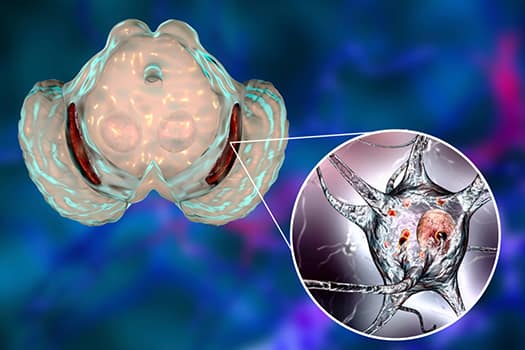What is Parkinson’s disease?
Definition
Parkinson’s disease is a neurological disease affecting about 1 to 2% of the population over 50 years of age, due to the degeneration of nerve cells in an area, located inside the brain (the black nucleus), and characterized by, among other things, trembling, slow movements, and stiffness.
Lewy body dementia is a degenerative type of dementia, characterized by the disruption of cognitive functions (loss of intellectual abilities of acquisition and knowledge), associated with visual hallucinations. To this is added the parkinsonian syndrome.
This involvement of the black nucleus causes a deficiency of dopamine secretion (neuromediator) which helps the regulation of the movements.
“Diabetics are 40% more likely to develop Parkinson’s.”
Possible causes
The common point between Alzheimer’s, Parkinson’s, autism and Multiple Sclerosis as well as many other neurological pathologies is inflammation. This inflammation starts in the intestine and then reaches the brain.
Different physiological mechanisms have been studied to explain the onset of Parkinson’s:
There are at least five tracks in etiological research and applied in practice:
- A porous intestine (in English, “Leaky gut”)
- The presence of enemy bacteria that are composed of LPS or lipopolysaccharides (1)
- Environmental contaminants including lead, manganese, solvents and some pesticides
- Mitochondrial disorder (Alzheimer’s and Parkinson’s)
- Lewi body (Alzheimer’s and Parkinson’s) (2)
Link between porous intestine and Parkinson’s
A porous intestine no longer protects the body from partially digested pathogens and food molecules. The same goes for the blood-brain barrier that is supposed to protect the brain.
These two defenses can fail when the intestines are subjected to repetitive pro-inflammatory molecules: gluten, refined sugars, refined flours, overheated, hydrogenated and/or trans fats, roasted animal proteins and personal allergenic foods.
Mitochondria are the chemical energy production plants in our cells. They need oxygen to function optimally. However, they eventually produce Reactive Oxygen Species (ROS) when they are disturbed.
ROS promote inflammation that develops mitochondrial disorders and Lewi bodies. The appearance of these may be similar to the scenario of plaques of atheroma and cholesterol that are deposited on the walls in the arteries. The arteries are damaged by excess blood sugar and circulating insulin.
Innovative paths
- Dietary changes: hypotoxic and anti-inflammatory diet
- Repair of the intestinal membrane too porous
- Specific probiotics
- Specific antioxidants that can cross the blood-brain barrier
- Good fats including omega 3, 7 and medium chain fatty acids
- Stress modulation; Mindfulness meditation
In summary, it is possible to prevent the disease based on risk factors and lifestyle.
References
(1) Intestinal Dysbiosis and Lowered Serum Lipopolysaccharide-Binding Protein in Parkinson’s Disease. Satoru Hasegawa, Sae Goto, and al.Published: November 5, 2015
http://dx.doi.org/10.1371/journal.pone.0142164
(2) Lewy Bodies: A Golden Spectator Salient Killer? Sian-Hulsmann J, Monoranu C, Strobel S, Riederer CNS Neurol Disord Drug Targets. 2015; 14 (7): 947-55.



Recent Comments